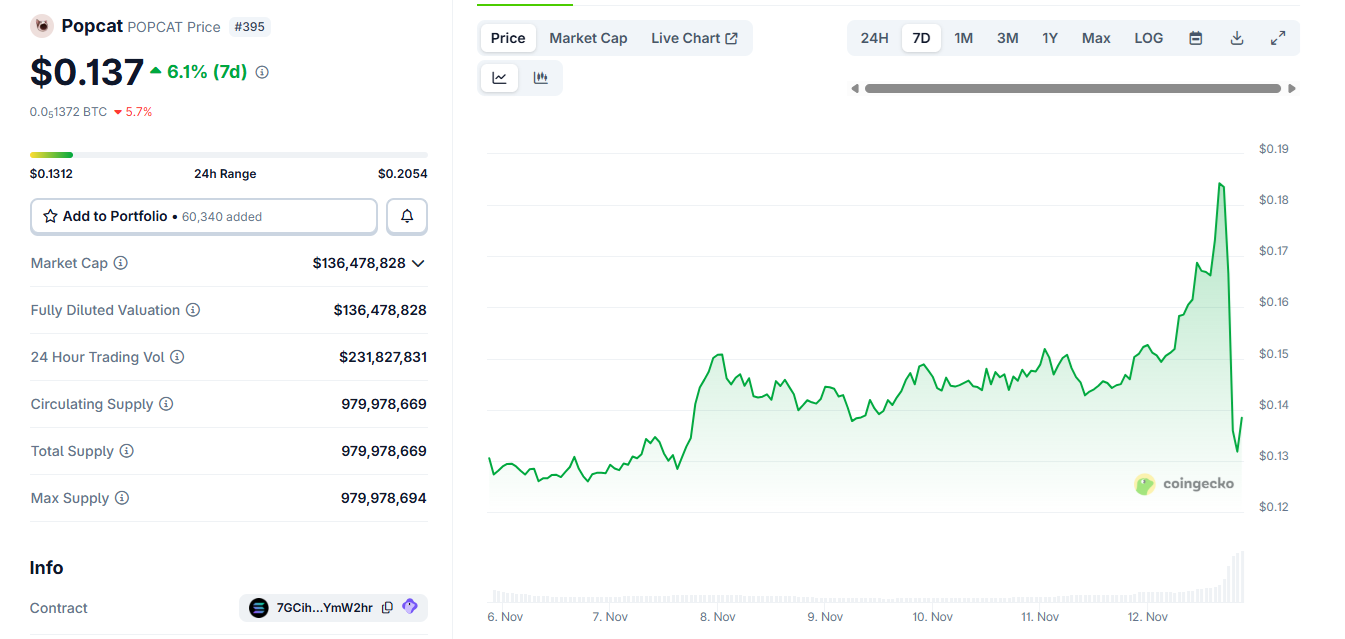A whale manipulated POPCAT’s price on Hyperliquid, spoofing demand to spike it to $0.20 before crashing it, resulting in a $5 million drain from the liquidity pool and widespread liquidations across exchanges.
-
POPCAT whale executed a multi-wallet spoofing attack on Hyperliquid, posting fake $20 million buy orders to artificially inflate the price.
-
The manipulation led to a temporary rally followed by a sharp decline, impacting traders on centralized platforms like Bybit and Coinbase.
-
Hyperliquid’s liquidity pool absorbed nearly $4.9 million in losses, prompting the platform to suspend deposits and withdrawals temporarily; trading volume surged 10x to $230 million.
Discover how a POPCAT whale’s Hyperliquid manipulation drained $5M from liquidity pools, spiking prices before chaos. Stay informed on meme token risks and protect your trades today.
What Caused the POPCAT Manipulation on Hyperliquid?
POPCAT manipulation on Hyperliquid stemmed from a coordinated whale attack using multiple wallets to spoof trading activity, artificially driving up the token’s price before liquidating positions for profit. This event, detected through on-chain analysis, exposed vulnerabilities in decentralized liquidity pools, leading to immediate platform restrictions on deposits and withdrawals. The incident highlighted ongoing risks in niche meme token markets, where aggressive trading can cascade into broader market disruptions.
How Did the Whale Execute the POPCAT Attack?
The whale behind the POPCAT Hyperliquid manipulation operated through a series of interconnected wallets over several hours, disguising the activity as genuine organic trading. By placing large buy orders totaling around $20 million at inflated prices, the attacker created the illusion of surging demand, pushing POPCAT’s value from its typical $0.13 range to a brief peak of $0.20. This spoofing tactic not only triggered a false rally but also lured other traders into long positions, amplifying the eventual fallout.
Once the price peaked, the whale abruptly halted buying and abandoned a $30 million long position, causing a rapid crash. On-chain data from platforms like Arkham Intelligence revealed that the losses from this liquidation—amounting to about $3 million for the whale—were offloaded onto Hyperliquid’s liquidity pool, which providers supply through the HLP vault. The pool ultimately bore $4.9 million in damages, as it was forced to hold and manually liquidate the oversized position.
This method mirrors previous incidents on Hyperliquid, such as the JellyJelly and TST manipulations earlier in the year. In those cases, similar tactics overwhelmed the platform’s risk mechanisms, leaving liquidity providers exposed. Experts from the blockchain analytics firm Nansen have noted that such attacks exploit the decentralized nature of perpetual futures markets, where large positions can strain automated safeguards. The POPCAT event, occurring in November 2025, underscores that Hyperliquid has yet to fully address these persistent vulnerabilities, potentially endangering other low-liquidity pools.
The attack’s sophistication was evident in its multi-wallet execution, which aimed to evade detection. Post-incident, the involved wallets bridged out all USDC from Hyperliquid’s ecosystem, suggesting a calculated exit strategy. While the whale incurred direct losses on its position, the broader harm to the platform and ecosystem participants far outweighed any individual gains, raising questions about the incentives behind such deliberate disruptions.
 POPCAT spiked and crashed, discovering a deliberate attempt to spoof the price on Hyperliquid, then abandon a $30M long position and causing nearly $5M in losses to the Hyperliquid liquidity pool. | Source: Coingecko
POPCAT spiked and crashed, discovering a deliberate attempt to spoof the price on Hyperliquid, then abandon a $30M long position and causing nearly $5M in losses to the Hyperliquid liquidity pool. | Source: CoingeckoFrequently Asked Questions
What Are the Long-Term Risks of Meme Token Manipulation Like POPCAT on Hyperliquid?
Meme token manipulations, such as the POPCAT incident on Hyperliquid, pose significant risks including liquidity pool drains and platform instability, as seen with $4.9 million in losses absorbed by providers. These events can erode trust in decentralized exchanges, leading to reduced participation and heightened volatility for similar assets. Regulators and analysts from Chainalysis emphasize monitoring on-chain patterns to mitigate future exploits in volatile markets.
Why Did POPCAT Trading Volumes Surge After the Hyperliquid Attack?
Following the Hyperliquid manipulation, POPCAT’s trading volumes exploded by 10 times to $230 million due to the price spike drawing speculative interest across exchanges like Bybit, Gate, and Coinbase. The artificial rally created FOMO among traders, but the subsequent crash triggered massive liquidations, wiping out over $61 million in long positions platform-wide. This chain reaction demonstrated how localized attacks can ripple through global crypto markets, affecting even established meme tokens.
Key Takeaways
- HLP Vaults Are Vulnerable: Hyperliquid’s liquidity provider vaults struggled to handle the $30 million position, resulting in $4.9 million losses and highlighting the need for improved risk controls in decentralized perpetuals.
- Spoofing Tactics Persist: The multi-wallet strategy used in the POPCAT attack echoes prior JellyJelly and TST events, indicating unaddressed flaws that could target other niche pools on the platform.
- Broader Market Impact: Liquidations spilled over to centralized exchanges, slashing open interest from $114 million to $41 million—traders should diversify and use stop-losses to navigate meme token volatility.
Conclusion
The POPCAT manipulation on Hyperliquid serves as a stark reminder of the fragility in meme token ecosystems, where a single whale’s actions can drain liquidity pools and trigger widespread liquidations exceeding $61 million. As platforms like Hyperliquid grapple with these recurring attacks, akin to those involving JellyJelly and TST, the crypto community must prioritize robust safeguards and on-chain vigilance. Looking ahead, enhanced monitoring tools and collaborative efforts among exchanges could prevent such disruptions, empowering traders to engage more securely in this dynamic space—consider reviewing your positions in volatile assets today to stay ahead of potential risks.
POPCAT, an established meme token from the early 2024 boom, has generally trended downward over the long term with subdued trading activity. However, the recent Hyperliquid event injected unprecedented volatility, briefly positioning it among the top daily gainers before the inevitable correction. This surge not only amplified short-term interest but also exposed interconnected risks across decentralized and centralized venues.
The manipulation’s ripple effects were felt immediately on major platforms, where POPCAT’s price action prompted reactive trading. Centralized exchanges reported heightened activity as arbitrageurs and retail participants chased the anomaly, only to face liquidations when the spoofed demand evaporated. On-chain investigations, drawing from data sources like Etherscan and Dune Analytics, confirmed the attack’s premeditated nature, with wallets linked to prior Hyperliquid exploits.
Delving deeper, the whale’s strategy involved posting high-volume buy orders to simulate bullish momentum, a classic market manipulation ploy in illiquid environments. This not only inflated the token’s notional value but also drew in leveraged longs, setting the stage for cascading failures. When the position was liquidated, the HLP vault—designed as a backstop for market makers—incurred the brunt of the damage, underscoring the perils of pooled liquidity in perpetual futures.
Hyperliquid’s response, halting deposits and withdrawals, was a necessary measure to stem further losses and investigate the breach. Yet, this incident reveals deeper systemic issues: niche pools for assets like POPCAT remain prime targets for sophisticated actors seeking to exploit thin order books. Blockchain security firms such as PeckShield have warned that without algorithmic enhancements or position size caps, similar events could recur, potentially destabilizing smaller DEXs.
For the POPCAT token itself, the episode had minimal lasting impact on its fundamentals, maintaining its position in the $0.13 range post-crash. However, the event eroded confidence in Hyperliquid’s infrastructure, prompting discussions on governance and liquidity management within the DeFi community. Traders worldwide experienced the fallout, with Bitcoin and Ethereum dominating overall liquidations but POPCAT ranking third due to its cross-platform presence.
In the aftermath, the attacking entity’s swift exit via USDC bridges suggests a hit-and-run operation, possibly motivated by testing platform limits or profiting from indirect chaos. As the crypto market evolves in 2025, events like this reinforce the importance of due diligence—investors should favor exchanges with proven resilience and transparent risk protocols to safeguard their portfolios against such unforeseen manipulations.
